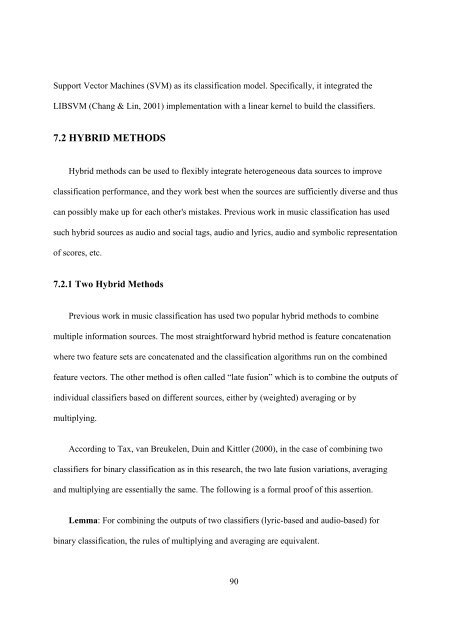improving music mood classification using lyrics, audio and social tags
improving music mood classification using lyrics, audio and social tags
improving music mood classification using lyrics, audio and social tags
Create successful ePaper yourself
Turn your PDF publications into a flip-book with our unique Google optimized e-Paper software.
Support Vector Machines (SVM) as its <strong>classification</strong> model. Specifically, it integrated the<br />
LIBSVM (Chang & Lin, 2001) implementation with a linear kernel to build the classifiers.<br />
7.2 HYBRID METHODS<br />
Hybrid methods can be used to flexibly integrate heterogeneous data sources to improve<br />
<strong>classification</strong> performance, <strong>and</strong> they work best when the sources are sufficiently diverse <strong>and</strong> thus<br />
can possibly make up for each other's mistakes. Previous work in <strong>music</strong> <strong>classification</strong> has used<br />
such hybrid sources as <strong>audio</strong> <strong>and</strong> <strong>social</strong> <strong>tags</strong>, <strong>audio</strong> <strong>and</strong> <strong>lyrics</strong>, <strong>audio</strong> <strong>and</strong> symbolic representation<br />
of scores, etc.<br />
7.2.1 Two Hybrid Methods<br />
Previous work in <strong>music</strong> <strong>classification</strong> has used two popular hybrid methods to combine<br />
multiple information sources. The most straightforward hybrid method is feature concatenation<br />
where two feature sets are concatenated <strong>and</strong> the <strong>classification</strong> algorithms run on the combined<br />
feature vectors. The other method is often called “late fusion” which is to combine the outputs of<br />
individual classifiers based on different sources, either by (weighted) averaging or by<br />
multiplying.<br />
According to Tax, van Breukelen, Duin <strong>and</strong> Kittler (2000), in the case of combining two<br />
classifiers for binary <strong>classification</strong> as in this research, the two late fusion variations, averaging<br />
<strong>and</strong> multiplying are essentially the same. The following is a formal proof of this assertion.<br />
Lemma: For combining the outputs of two classifiers (lyric-based <strong>and</strong> <strong>audio</strong>-based) for<br />
binary <strong>classification</strong>, the rules of multiplying <strong>and</strong> averaging are equivalent.<br />
90
















